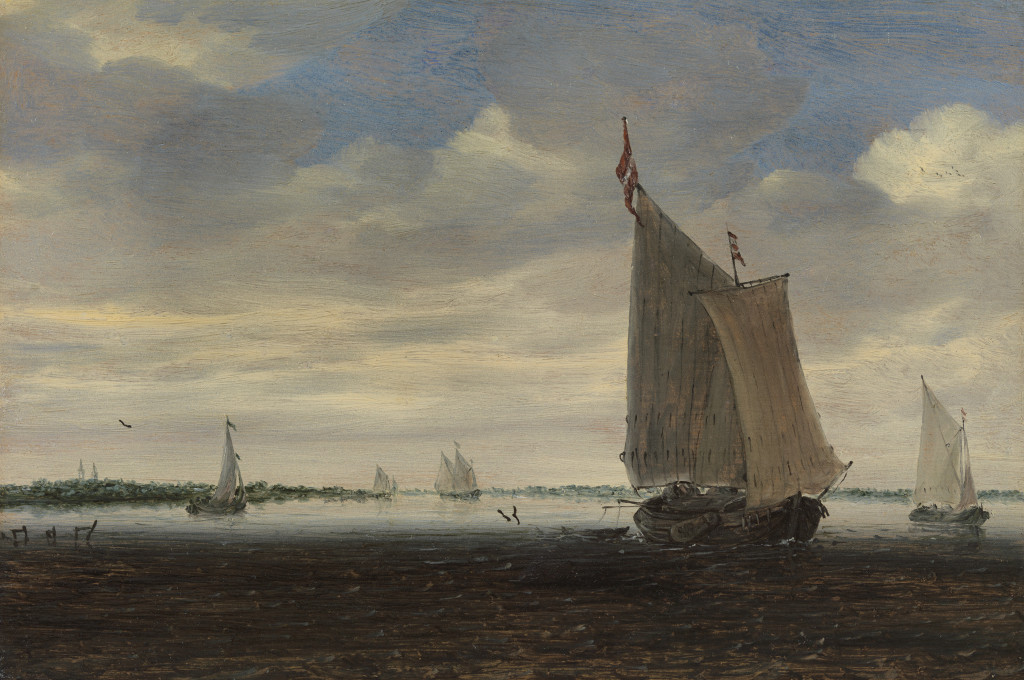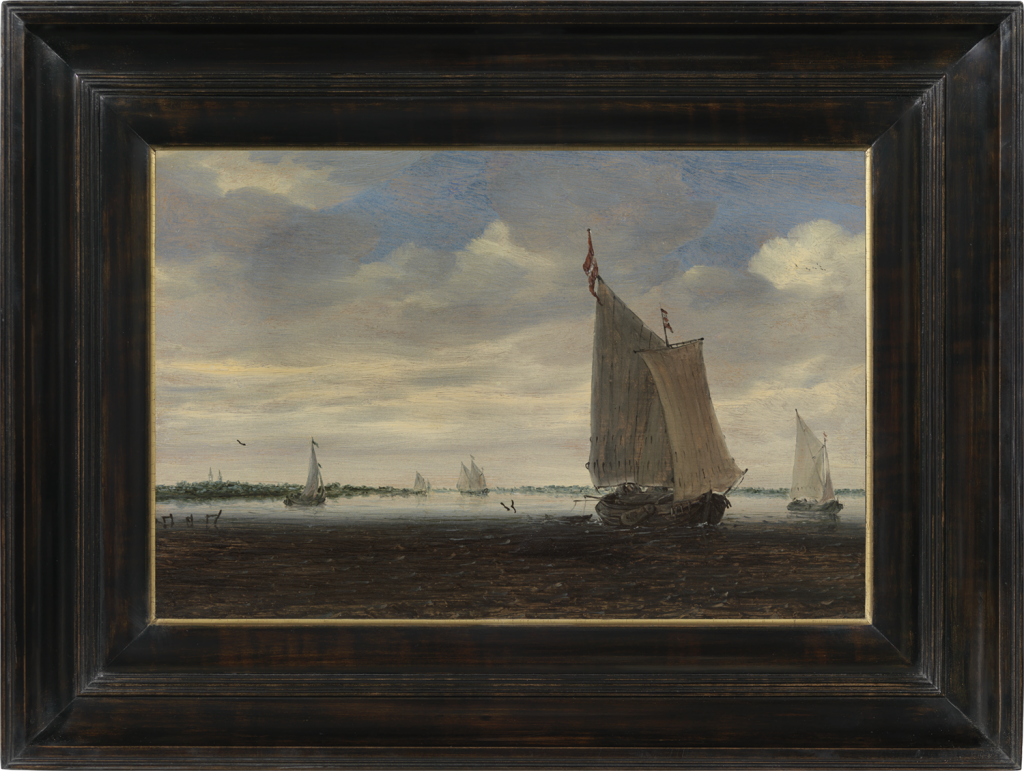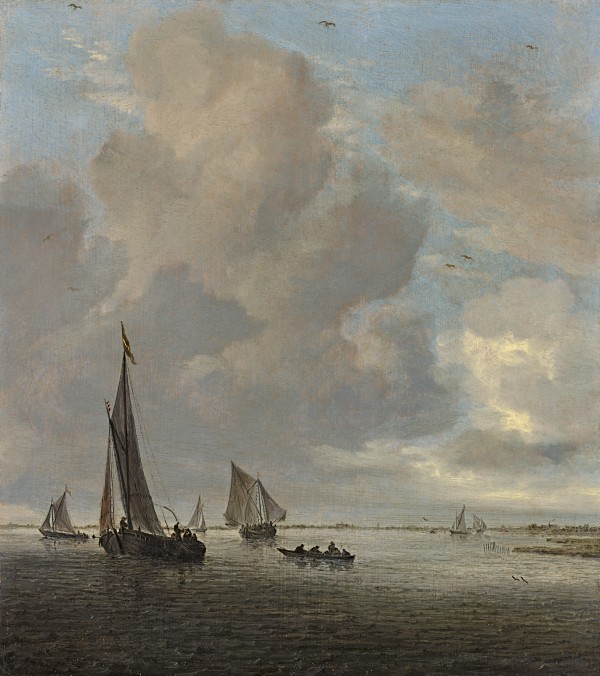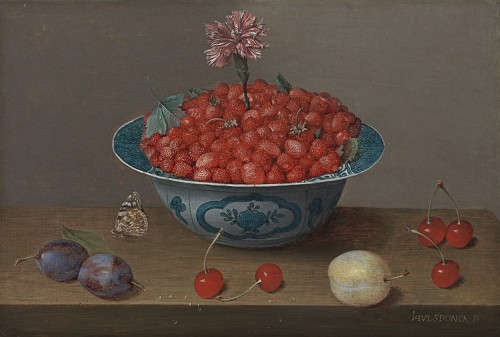SALOMON VAN RUYSDAEL
Naarden 1600/03 - 1670 Haarlem
Ref: BT 300
A wijdschip and other small Dutch vessels on the Haarlemmermeer, with Heemstede Castle in the distance
Signed with initials lower right: SvR
Oil on panel: 8 5/8 x 12 3/8 in / 21.9 x 31.4 cm
Frame size: 13 ½ x 17 ¼ in / 34.3 x 43.8 cm
Painted circa 1645-46
Provenance:
Frederik Muller & Cie., Amsterdam, 25th April 1911, lot 96 (Fl.3,800)
R Page-Croft;
Christie’s London, 28th June 1974, lot 15 (£19,950 to Konig)
P de Boer, Amsterdam, 1978
Private collection, Europe
Literature:
W Stechow, Salomon van Ruysdael. Eine Einführung in seine Kunst, Berlin 1938, p.113, no.302 W Stechow, Salomon van Ruysdael, Berlin 1975, p.113, no.302
Salomon van Ruysdael was the poet of Dutch waterways, depicting tree-fringed rivers with laden ferry boats, frozen inland waterways with townsfolk enjoying the pleasure of skating, and shorelines with the cargo vessels that were the lifeblood of the Dutch economy. In the seventeenth century, there was less drained land in the northern Netherlands than there is today and by far the easiest means of transport was by boat. Travel along the canals between towns was very efficient; Haarlem, for example, had an hourly barge service to Amsterdam.
In the mid-1640s Ruysdael began to paint small works on panel in which boats float on an uncluttered foreground against a vast sky. He developed this theme into the following decade. Although comparatively small in compass, there is a wonderful sense of airy panorama in this painting of A wijdschip and other small Dutch vessels on the Haarlemmermeer, with Heemstede Castle in the distance. The view is looking north with gentle, late afternoon light and a north-west breeze[1]. In the left distance are the unequal turrets of Heemstede Castle, originally built by Dirk van Hoylede in 1280. In the centre distance is the junction of the Spaarne river with the Haarlemmermeer. A number of small merchant ships are coming from Haarlem on their way to Leiden in the south. The shadowed foreground, painted with quick, flickering strokes, enhances the depth of the composition, while a band of silvery water, lit from the parting clouds, leads the eye far into the distance.
By the 1640s, when this painting was made, Ruysdael had moved away from the ‘tonal’ phase of Dutch landscape painting popular in the 1630s, while still retaining elements of its subtle, harmonious palette. The grey-browns of the foreground water harmonise with the buff and grey sails of the foreground, shadowed boat and with the grey-green of the landscape on the horizon. Brighter, local colours are provided by the red and white flags on the boat and the intense blue of the sky seen through scudding clouds.
Ruysdael ‘draws’ with brush tip to describe the intricacies of the vessels and a couple of flicks of the hand place the three seagulls, one soaring above the left horizon, the other pair dipping down to the point where the silver band of water begins. In contrast to the agitated brushwork of the foreground, the sky is evoked in long, horizontal strokes, blending soft white, warm grey and the faintest hint of pink to suggest a sunset. The painting exudes calm and the classicism that was to come to dominate Dutch landscape as the century progressed.
Although Salomon van Ruysdael lived in Haarlem all his life and painted landscapes throughout the northern Netherlands and western Germany, only a handful of views by him depicting clearly identifiable topography of the region round Haarlem are known. A similar view of the Haarlemmermeer, showing St Bavo’s church in Haarlem in the distance as well as Heemstede Castle, signed and dated 1647, is in an American private collection[2]. This painting also has affinities with Sailing boat and rowing boat, dated 1642, formerly in the collection of Sir Edmund Bacon, Bt. at Raveningham Hall, Norfolk[3].
The Haarlemmermeer is today a polder, reclaimed in the nineteenth century, on which Amsterdam’s airport stands. In Ruysdael’s day a series of lakes facilitated navigation between Haarlem and the villages and cities to the south. Heemstede Castle, on the Spaarne south of Haarlem, was bought by Adriaan Pauw (1585-1653) in 1620. He served as Grand Pensionary and was one of the delegates of the Dutch Republic at the Treaty of Münster in 1648, which brought to an end the Thirty Years’ War. Heemstede Castle was demolished in 1810.
Print after Roelant Roghman (1627-1692) depicting Heemstede Castle.
Nineteenth century map showing the Haarlemmermeer before land reclamation.
Salomon van Ruysdael, View of Haarlem from Lake Haarlemmermeer, 1647.
Oil on panel: 20 x 27 in / 50.8 x 68.6 cm.
Private collection, USA.
SALOMON VAN RUYSDAEL
Naarden 1600/03 - 1670 Haarlem
Salomon Jacobsz van Ruysdael was born in Naarden in Gooiland. He was originally called Salomon de Gooyer (Goyer), but he and his brother Isaack (1599-1677), also an artist, adopted the name ‘Ruysdael’ from Castle Ruisdael (or Ruisschendael), near their father's home town. Salomon spelled his name Ruysdael (or occasionally Ruyesdael), as distinguished from his nephew Jacob, who used the name Ruisdael. Salomon entered the painters’ guild in Haarlem in 1623 (as Salomon de Gooyer), was named vinder of the guild in 1647, dean the following year, and a vinder again in 1669. His earliest dated painting is of 1626, and as early as 1628 he was praised as a landscapist by the chronicler of Haarlem, Samuel van Ampzing. In a document of 1651 he was also called a merchant, and dealt in blue dye for Haarlem's bleacheries. His wife, Maycken Buysse, was buried in St Bavo Church in Haarlem on 15th December 1660. Like his father, Salomon was a Mennonite and was listed as such when he was living on the Kleyne Houtstraat in 1669. His religion forbad him to bear arms but he contributed to Haarlem’s civic guard. Although he seems to have lived in Haarlem all his life, he undoubtedly travelled in the country; his paintings depict scenes in, among other places, Leiden, Utrecht, Amersfoort, Arnhem, Alkmaar, Rhenen, Dordrecht and Weesp. The artist was buried in St Bavo’s Church on 3rd November 1670.
Although Salomon’s teacher is unknown, his earliest works of c.1626-29 recall the art of Esaias van de Velde (1587-1630), who worked in Haarlem from 1609-1618. Salomon’s early works also show many parallels with the landscapes of Jan van Goyen and Pieter de Molijn and it is likely that all three influenced one another. In addition to numerous landscapes, river views and seascapes of calm - never stormy - weather, Salomon also painted a few still lifes in his later years. Salomon was the father of Jacob Salomonsz. van Ruysdael (c.1629/30-1681), also a painter.
[1] We are very grateful to Dr Norbert Middelkoop, Senior Curator of Paintings, Prints and Drawings at the Amsterdam Museum, for identifying the view and providing details of the topography.
[2] View of Haarlem from Lake Haarlemmermeer, 1647. Oil on panel: 20 x 27 in / 50.8 x 68.6 cm. Private collection, USA. See Norbert Middelkoop and Alexander de Bruin, Views of Haarlem: the City Depicted in the Seventeenth Century, 2024, pp.48-49, illus. in colour.
[3] Stechow, op. cit., p.110, no.280, illus. pl.38, fig. 52.


























